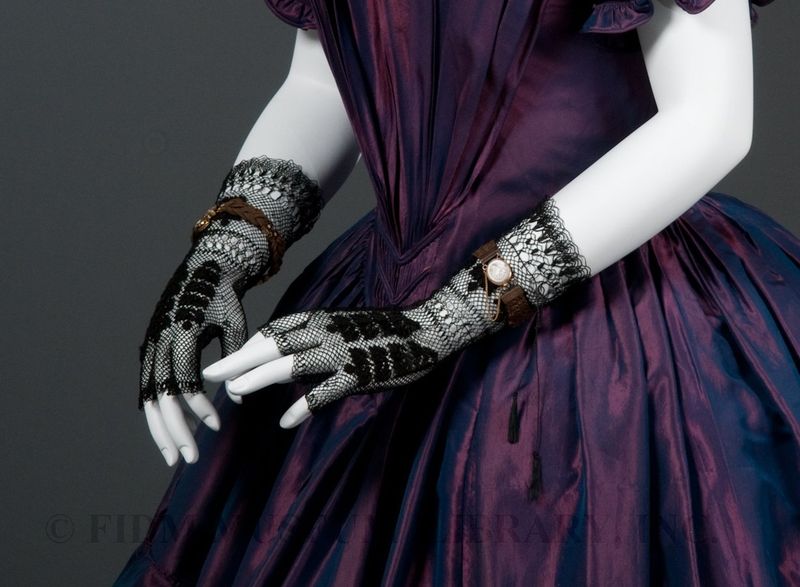Lace mitts
If these black mitts remind you of circa 1980s Madonna, you're not alone. The first time I encountered a pair of black 19th century mitts, I instantly remembered the fingerless lace gloves Madonna wore throughout much of the 1980s. She wears a black pair in the video for her 1984 hit Lucky Star.
 Fingerless mitts or gloves
Fingerless mitts or gloves
1830s
Cotton and embroidery
Gift of John Kauke
82.404.3AB
Pinning down the role of fingerless gloves in the 19th century has proved difficult. There are many extant examples of this accessory, but initial research suggests that they didn't receive extensive coverage in 19th century fashion literature. In general, gloves were an important part of a lady's wardrobe. Gloves were always worn "in church or in a theatre," and in most social situations outside the home.1 Gloves could be removed when inside the home with close friends or family, and were never worn during meals.
Black mitts were commonly paired with evening wear. Simultaneously revealing and concealing, mitts were probably a nod to propriety while allowing for greater freedom of movement. The sheer styles also drew attention to small, delicate hands. In the image above, black mitts enrich on evening ensemble of iridescent purple silk dating from 1845-46. The back of each mitt is embroidered in a leaf pattern. In 1840, Godey's Lady's Book described the popularity of black mitts: "Long and short gloves and mittens, of black filet, are universally adopted."2 Filet describes a geometric openwork pattern like that seen in the mitts above. Not all mitts featured openings for each finger; some pairs had only two openings, one for the thumb and another for the other four fingers.
Though black mitts were apparently the most popular, there were also mitts in other colors, including white, yellow and pink. Fashion magazines of the 19th century, including Godey's and Peterson's, frequently featured mitt patterns, though they could also be purchased ready-made. Published patterns usually suggested black with additional embellishment of red, green or blue. Based on an informal survey of when mitt references appear, the style had surprising longevity. In 1873, over 40 years after the Godey's reference , Harper's Bazaar informed its readers that "Black lace mitts of the finest possible texture, made with deep flowing cuffs, will be worn in midsummer." The writer continued, noting that the style was definitely nostalgic, as black lace mitts were "worn by our grandmothers."3 Yet more evidence pointing to the cyclical nature of fashion!
1 Day, Charles William. Hints on etiquette and the usages of society: with a glance at bad habits. Boston: William D. Ticknor & Co. 1843: 67.
2 "Chit Chat of Fashions" Godey's Lady's Book Jan 1840: 48.
3 "New York Fashions." Harper's Bazaar 22 March, 1873: 179.